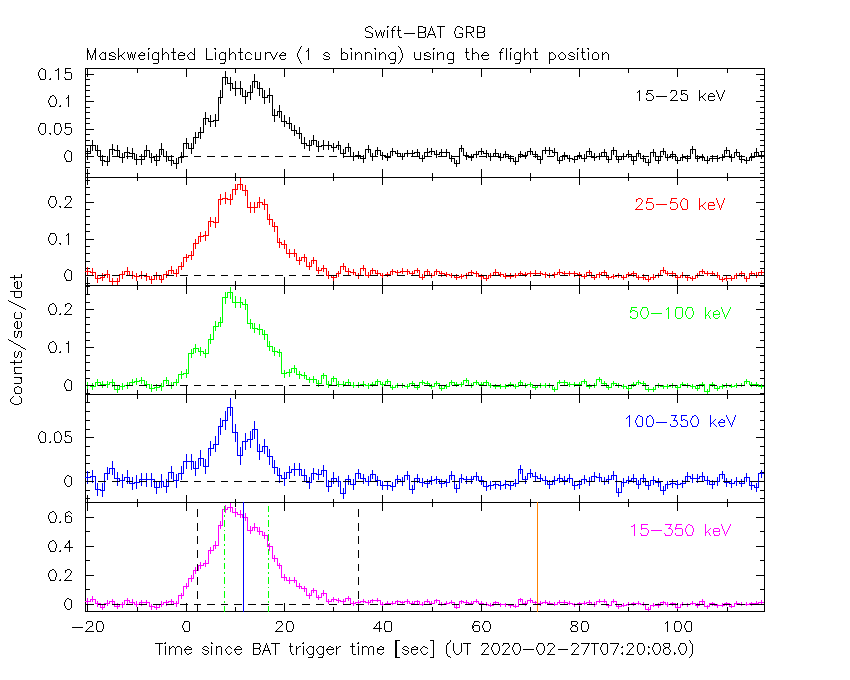
S. Laha (GSFC/UMBC/CRESST), J.A. Kennea (PSU) and S.R. Oates (U. Birmingham) for the Swift team
At 07:20:08 UT, the Swift Burst Alert Telescope (BAT) triggered and located GRB 200227A (trigger=958592) (Laha et al. GCN Circ. 27234). Swift slewed immediately to the burst. At the time of the trigger, the initial BAT position was 79° from the Sun (5.1 hours East) and 39° from the 12%-illuminated Moon. Table 1 contains the best reported positions from Swift, and the latest XRT position can be viewed at http://www.swift.ac.uk/xrt_positions.
Table 2 is a summary of GCN Circulars about this GRB from observatories other than Swift.
Standard analysis products for this burst are available at https://gcn.gsfc.nasa.gov/swift_gnd_ana.html.
As reported by Cummings et al. (GCN Circ. 27246),
the BAT ground-calculated position is RA, Dec = 56.433, 9.489 deg, which is RA(J2000) = 0
The mask-weighted light curve (Figure 1) a couple overlapping peaks starting at T-10 s, peaking at T+8 s, and ending at T+90 s.
The time-averaged spectrum from T-0.50 to T+87.64 s is best fit by a power law with an exponential cutoff.
This fit gives a photon index 1.15 ± 0.19, and
The results of the batgrbproduct analysis are available at https://gcn.gsfc.nasa.gov/notices_s/958592/BA/.
Analysis of the initial XRT data was reported by Kennea et al. (GCN Circ. 27249). We have analysed 8.6 ks of XRT data for GRB 200227A, from 72 s to 127.3 ks after the BAT trigger. The data comprise 288 s in Windowed Timing (WT) mode (the first 8 s were taken while Swift was slewing) with the remainder in Photon Counting (PC) mode. The enhanced XRT position for this burst was given by Beardmore et al. (GCN Circ. 27243).
The late-time light curve (Figure 2) (from T0+4.8 ks) can be modelled with a power-law decay with a decay index of α=1.11 (+0.18, -0.16).
A spectrum formed from the WT mode data can be fitted with an absorbed power-law with a photon spectral index of 1.88 (+0.08, -0.07). The best-fitting absorption column is 5.9 ± 0.5 x 1
A summary of the PC-mode spectrum is thus:
Total column: 5.6 (+1.1, -1.0) x 1
Galactic foreground: 2.1 x 1
Excess significance: 5.7 σ
Photon index: 1.83 (+0.17, -0.16)
The results of the XRT team automatic analysis are available at http://www.swift.ac.uk/xrt_products/00958592.
The Swift/UVOT began settled observations of the field of GRB 200227A 93 s after the BAT trigger
(Oates and Laha GCN Circ. 27244).
No optical afterglow consistent with the XRT position (Beardmore et al. GCN Circ. 27243) is detected in the initial UVOT exposures.
Table 3 gives preliminary
magnitudes using the UVOT photometric system
(Breeveld et al. 2011, AIP Conf. Proc., 1358, 373).
No correction has been made for the expected extinction in the Milky Way
corresponding to a reddening of

Figure 1. The BAT
mask-weighted light curve in the four individual and total
energy bands. The units are counts

Figure 2. The XRT light curve.
Any data from a crosshatched region are not included in the fit.
| RA (J2000) | Dec (J2000) | Error | Note | Reference |
|---|---|---|---|---|
| 0 |
+09°28'57.1" | 1.4" | XRT-final | UKSSDC |
| 0 |
+09°28'56.3" | 2.5" | XRT-enhanced | Beardmore et al. GCN Circ. 27243 |
| 0 |
+09°29'22.0" | 1.0' | BAT-refined | Cummings et al. GCN Circ. 27246 |
| Band | Authors | GCN Circ. | Subject | Observatory | Notes |
|---|---|---|---|---|---|
| Optical | Oeda et al. | 27236 | MITSuME Akeno optical upper limit | MITSuME Akeno | upper limits |
| Optical | Belkin et al. | 27257 | Mondy optical upper limit | Mondy | upper limits |
| Optical | Watson et al. | 27265 | RATIR Optical Observations | RATIR | upper limits |
| Gamma-ray | Fermi | 27233 | Fermi GBM Final Real-time Localization | Fermi GBM | |
| Gamma-ray | Bissaldi | 27239 | Fermi GBM observation | Fermi GBM | Fluence=1.41±0.04x1 (8 |
| Gamma-ray | Luo et al. | 27251 | Insight-HXMT/HE detection | Insight-HXMT |
| Filter | Exp(s) | Mag | ||
|---|---|---|---|---|
| whit |
93 | 243 | 147 | >20.3 |
| 305 | 555 | 246 | >19.7 | |
| white | 93 | 1185 | 353 | >20.8 |
| v | 634 | 1235 | 78 | >18.3 |
| b | 560 | 1160 | 58 | >19.2 |
| u | 305 | 1135 | 285 | >19.8 |
| w1 | 685 | 1284 | 58 | >18.4 |
| m2 | 659 | 1259 | 78 | >18.4 |
| w2 | 610 | 1210 | 78 | >18.6 |
Table 3. UVOT observations reported by Oates and Laha (GCN Circ. 27244). The start and stop times of the exposures are given in seconds since the BAT trigger. The preliminary 3-σ upper limits are given. No correction has been made for extinction in the Milky Way.
March 2, 2020